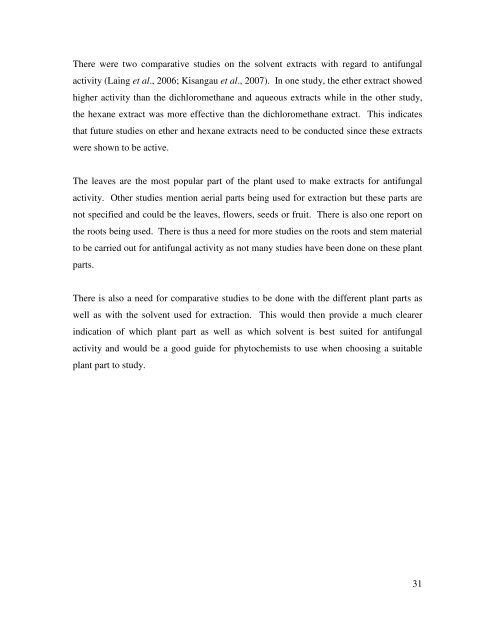university of kwazulu-natal faculty of science and agriculture school ...
university of kwazulu-natal faculty of science and agriculture school ...
university of kwazulu-natal faculty of science and agriculture school ...
Create successful ePaper yourself
Turn your PDF publications into a flip-book with our unique Google optimized e-Paper software.
There were two comparative studies on the solvent extracts with regard to antifungal<br />
activity (Laing et al., 2006; Kisangau et al., 2007). In one study, the ether extract showed<br />
higher activity than the dichloromethane <strong>and</strong> aqueous extracts while in the other study,<br />
the hexane extract was more effective than the dichloromethane extract. This indicates<br />
that future studies on ether <strong>and</strong> hexane extracts need to be conducted since these extracts<br />
were shown to be active.<br />
The leaves are the most popular part <strong>of</strong> the plant used to make extracts for antifungal<br />
activity. Other studies mention aerial parts being used for extraction but these parts are<br />
not specified <strong>and</strong> could be the leaves, flowers, seeds or fruit. There is also one report on<br />
the roots being used. There is thus a need for more studies on the roots <strong>and</strong> stem material<br />
to be carried out for antifungal activity as not many studies have been done on these plant<br />
parts.<br />
There is also a need for comparative studies to be done with the different plant parts as<br />
well as with the solvent used for extraction. This would then provide a much clearer<br />
indication <strong>of</strong> which plant part as well as which solvent is best suited for antifungal<br />
activity <strong>and</strong> would be a good guide for phytochemists to use when choosing a suitable<br />
plant part to study.<br />
31

















